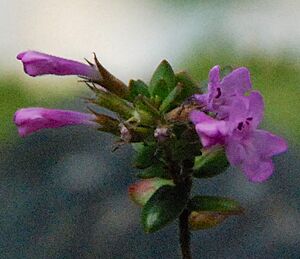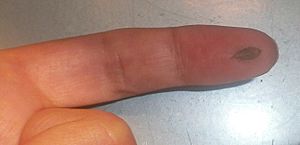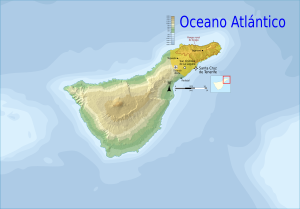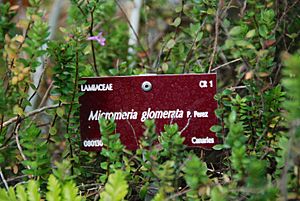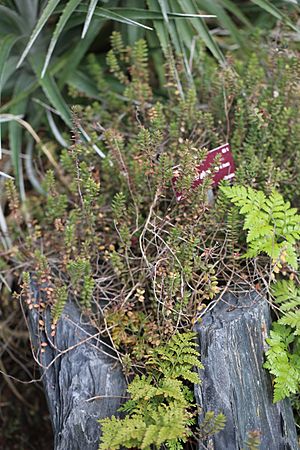Micromeria glomerata facts for kids
Quick facts for kids Micromeria glomerata |
|
|---|---|
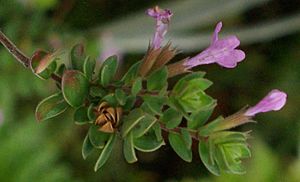 |
|
| Conservation status | |
| Scientific classification | |
| Genus: |
Micromeria
|
| Species: |
glomerata
|
The Micromeria glomerata, also known as cliff thyme or thyme of Taganana, is a special plant. It has woody stems and pink-purple flowers. This plant belongs to the mint family, called Lamiaceae.
It only grows in the northeast part of Tenerife, one of the Canary Islands. A botanist named Pedro Luis Pérez de Paz first described it in 1974. This plant is used for medicine and has a nice smell. It grows low to the ground in cracks on the slopes of the Anaga Rural Park. Its flexible stems can grow from 10 to 40 centimeters tall. The leaves are small and flat, about 8 millimeters long and 6 millimeters wide.
In 1991, another scientist thought he found a new plant and called it Satureja anagae. But it turned out to be the same plant, Micromeria glomerata. The main sample of this plant, collected in 1972, is kept at the University of La Laguna. Because it grows in such a small area and faces threats, it is considered Critically Endangered. Some botanical gardens, like the Conservatoire botanique national de Brest, are helping to protect it.
Contents
What Does Cliff Thyme Look Like?
Stems and Leaves
Micromeria glomerata is a plant that grows close to the ground. Its main sample was collected on May 27, 1972. It is stored at the herbarium of the University of La Laguna.
Depending on where it grows, this plant can have small, woody stems. These stems can be straight or branched, growing 10 to 40 centimeters above the ground. They are flexible and have soft hairs. Older stems can turn red. The top parts of the stems have many thin branches.
The leaves are small and flat, about 8 millimeters long and 6 millimeters wide. They are shaped like an oval or a spearhead. They attach directly to the stem or have very short stalks. The leaves are often reddish, especially when they get a lot of sun. This red color comes from special pigments called anthocyanins. These pigments help protect the plant from strong sunlight, like a natural sunscreen. The bottom of the leaves has a few soft hairs, while the top is smooth and bright green.
Flowers and Seeds
The flowers of Micromeria glomerata are about one centimeter long. They are a pretty pink-purple color. These flowers grow in clusters at the end of the plant's branches.
Each cluster has three to ten flowers. They grow on small stalks and have tiny, hairy leaf-like parts called bracts. The cup-like part of the flower, called the calyx, is about 8 millimeters wide. It has 13 to 15 ridges and is hairy on the outside. The colorful part of the flower, called the corolla, is about twice as long as the calyx. It is purple and has hairs on its upper outer part. After the flowers bloom, they produce small, oblong seeds.
How Cliff Thyme Evolved
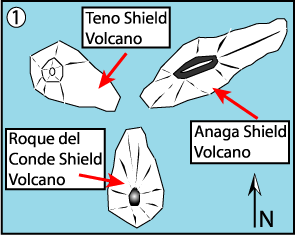
Scientists have studied the Micromeria group of plants. They found that this group split into two main types. One type grows in Spain and Morocco. The other type grows only in the Canary Islands, including Tenerife.
The Canary Islands group can be divided into three smaller groups. Micromeria glomerata belongs to the oldest group found in the Macizo de Anaga area. This group also includes two other species: Micromeria teneriffae and Micromeria rivas-martinezii. Scientists believe that Micromeria glomerata separated from its common ancestor about 8.4 million years ago. Its more recent form appeared about 2.7 million years ago.
This plant was first officially found on February 8, 1972, by Pedro Luis Pérez de Paz. He was hiking when he saw it. Later that year, he collected samples and realized it was different from other similar plants. Two years later, it was officially added to the list of Micromeria species in the Canary Islands.
The name Micromeria glomerata was given by its discoverer in 1974. Locally, people call it "thyme," "cliff thyme," or "thyme of Taganana." In 1991, another scientist mistakenly thought it was a new species and named it Satureja anagae. But it was later confirmed to be the same plant.
Where Cliff Thyme Lives
Micromeria glomerata is a plant that only grows on the island of Tenerife in the Canary Islands, Spain. It lives at heights between 300 and 485 meters above sea level. You can find it in the protected area of the Anaga Rural Park, near Taganana.
In 2004, about 490 of these plants were counted. They were found in two main groups. The larger group had about 460 plants, and the smaller one had fewer than 30. These plants grow on steep rocks and in cracks on slopes that face north and northwest. The total area where they grow is about 6,500 square meters.
Life Cycle of Cliff Thyme
Cliff thyme flowers in the spring, usually in May and June. Its fruits develop in the summer, in July and August. When the seeds are ready, they come out of the dry flower parts and are carried away by the wind.
In the summer, Micromeria glomerata loses some of its leaves. The leaves that remain often turn a reddish color.
Why Cliff Thyme Needs Protection
Micromeria glomerata is one of two Micromeria species that are Critically Endangered, according to the IUCN. This means it is at very high risk of disappearing forever. Over time, the area where it can grow has become smaller.
In 1996, human activities, like animals eating plants in the area, threatened the species. This limited where the plants could spread. To help save it, scientists have suggested growing the plant in botanical gardens. In 2010, efforts were made to store the plant's seeds in a special seed bank. They also worked to stop animals from eating plants in the Anaga region.
The 2013 IUCN report noted that the places where this plant grows are often hard to reach. Animals like rabbits and goats eating the plants can also stop them from spreading. Sometimes, Micromeria glomerata can mix with another plant called Micromeria varia. This mixing can also be a threat to its survival.
Since 2008, the plant has been grown in special greenhouses at the Conservatoire botanique national de Brest. These greenhouses try to copy the climate of the Canary Islands to help the plant grow.
How Cliff Thyme Is Used
This plant is interesting for people who like to grow plants in their gardens, especially in rock gardens. It is also used as an aromatic plant because of its pleasant smell and taste, similar to thyme.
People have also used it as a medicinal plant. However, it is not certain if this use has made it rarer.
See also
 In Spanish: Micromeria glomerata para niños
In Spanish: Micromeria glomerata para niños
- Micromeria
Images for kids



